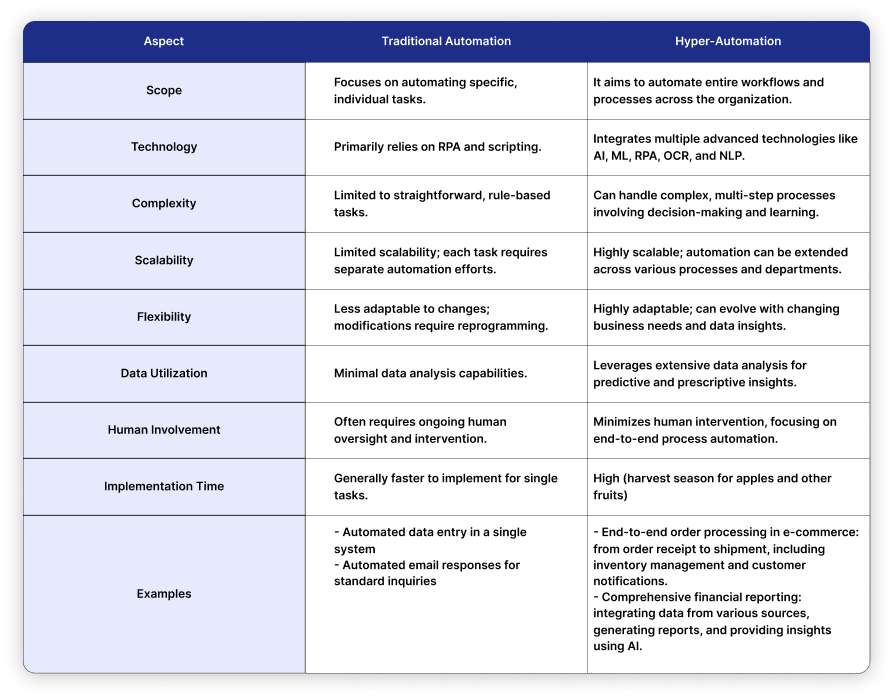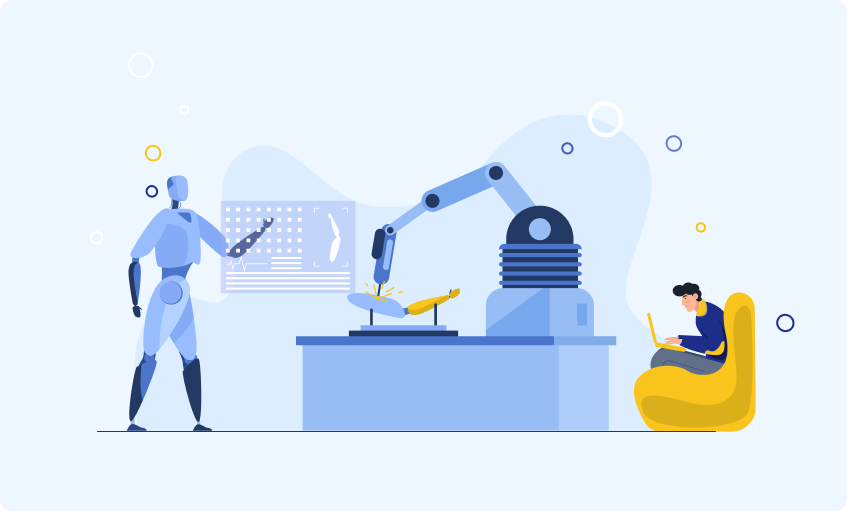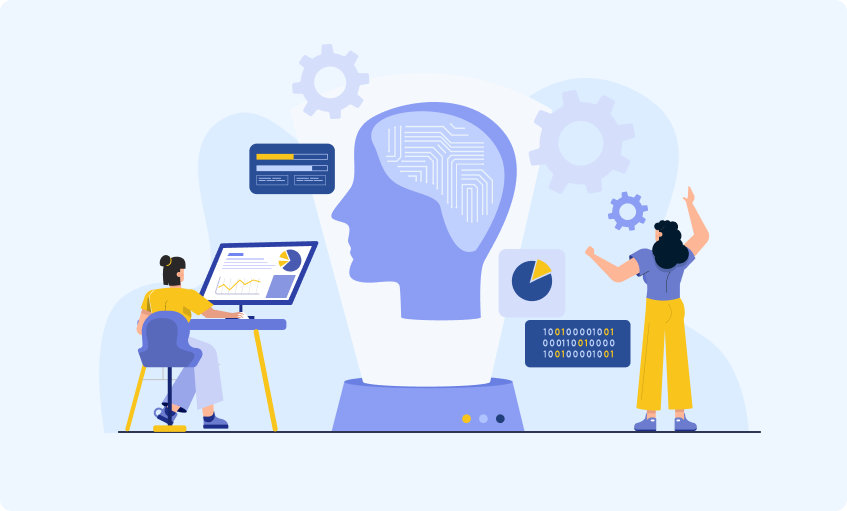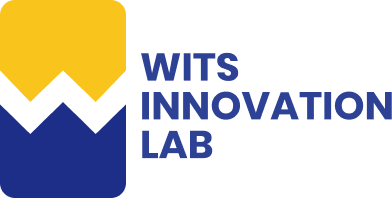Published - 2 years ago | 13 min read
Hyper-Automation: The Future of Intelligent Automation
Corporate entities have been looking for methods to improve their performance, cut costs, and remain relevant in the technological environment. Hyper-Automation is emerging as a key approach to enabling these goals. It uses various modern technologies, such as AI, ML, RPA, and others, to automate business processes and workflows. This blog post focuses on Hyper-Automation, its elements, advantages, drawbacks, and uses in practice.
What is Hyper-Automation?
Hyper-Automation is the use of advanced technologies to automate business processes system-wide. While automation is a way to automate specific processes, Hyper-Automation is an approach that aims to integrate numerous automations into a single system. This involves the systematic integration of several technologies, such as AI, ML, RPA, OCR, and NLP, to form an integrated automation solution.
Key Components of Hyper-Automation

Robotics Process Automation or (RPA)
Function: RPA is specifically intended for working with IT tasks that involve rule-based, repetitive operations conventionally executed by people. Such activities cover data input, accounting of bills, and responding to clients' requests via messages.
RPA involves using software robots, commonly called "bots," to replicate human activity with computers. Such bots can move around in systems, input information, complete transactions, and initiate responses in different applications. As repetitive tasks are taken over by robots, human employees can be deployed to activities that create value. For instance, in the case of banking, RPA can perform customer onboarding where the system extracts information from documents, validates newly entered data, and updates customer records, all without human interaction, thus speeding up the process and minimizing errors.
Examples: Transcription services, accounts receivable, and handling customer inquiries using virtual assistants.
Function: RPA is specifically intended for working with IT tasks that involve rule-based, repetitive operations conventionally executed by people. Such activities cover data input, accounting of bills, and responding to clients' requests via messages.
RPA involves using software robots, commonly called "bots," to replicate human activity with computers. Such bots can move around in systems, input information, complete transactions, and initiate responses in different applications. As repetitive tasks are taken over by robots, human employees can be deployed to activities that create value. For instance, in the case of banking, RPA can perform customer onboarding where the system extracts information from documents, validates newly entered data, and updates customer records, all without human interaction, thus speeding up the process and minimizing errors.
Examples: Transcription services, accounts receivable, and handling customer inquiries using virtual assistants.
Artificial Intelligence (AI)
Function: AI is a progressive technology whereby a system is designed to mimic human intelligence, which includes elements like thinking, learning, and computing.
To be specific, AI is an extensive subject that consists of the following branches: natural language processing, computer vision, and predictive analysis. This is because they can process huge volumes of data and make good sense of them by feeding them to an analytical interface. In Hyper-Automation, AI is central as it expands and improves the potential of RPA through the creation of intelligent bots. For example, it can be applied to customer relations, wherein the software reviews customer complaints, assesses the customer's attitude, and responds to the customer or refers the case to the managers if necessary. This helps not only to increase response speed but also to improve the quality of the service provided to customers.
Examples: Predictive modeling, fraud detection, and customer behavior analysis.
Function: AI is a progressive technology whereby a system is designed to mimic human intelligence, which includes elements like thinking, learning, and computing.
To be specific, AI is an extensive subject that consists of the following branches: natural language processing, computer vision, and predictive analysis. This is because they can process huge volumes of data and make good sense of them by feeding them to an analytical interface. In Hyper-Automation, AI is central as it expands and improves the potential of RPA through the creation of intelligent bots. For example, it can be applied to customer relations, wherein the software reviews customer complaints, assesses the customer's attitude, and responds to the customer or refers the case to the managers if necessary. This helps not only to increase response speed but also to improve the quality of the service provided to customers.
Examples: Predictive modeling, fraud detection, and customer behavior analysis.
Machine Learning (ML)
Function: Machine Learning (ML) can be described as the use of algorithms to allow a system to learn and improve from experience or data that is inputted into it without having to be programmed.
This is because Machine Learning algorithms embrace the ability to make predictions from historical data. These can continue to be refined as they are trained with more data sets. In Hyper-Automation, the role of ML is highly critical and includes aspects like predictive maintenance, identification of frauds, or even setting dynamic prices. For example, in predictive maintenance, ML algorithms can look at the sensors collected from the machinery to identify the likelihood of a particular component failing and then take preventive measures to avoid any downtimes. This capability enables the HC to maintain the equipment more proficiently and at lower costs.
Examples: The applications include recommendation engines, anomaly detection, and dynamic pricing models.
Function: Machine Learning (ML) can be described as the use of algorithms to allow a system to learn and improve from experience or data that is inputted into it without having to be programmed.
This is because Machine Learning algorithms embrace the ability to make predictions from historical data. These can continue to be refined as they are trained with more data sets. In Hyper-Automation, the role of ML is highly critical and includes aspects like predictive maintenance, identification of frauds, or even setting dynamic prices. For example, in predictive maintenance, ML algorithms can look at the sensors collected from the machinery to identify the likelihood of a particular component failing and then take preventive measures to avoid any downtimes. This capability enables the HC to maintain the equipment more proficiently and at lower costs.
Examples: The applications include recommendation engines, anomaly detection, and dynamic pricing models.
Optical character recognition (OCR)
Function: Optical Character Recognition (OCR) refers to the process by which different kinds of paper documents, scanned documents, PDFs, or even digital images are transformed into data that can be edited and searched.
OCR proves useful for scanning and text recognition from physical papers and media. OCR's scanning of printed or handwritten text facilitates the automation of document-bound routines since it translates the content into machine-readable form. For instance, in the insurance industry, OCR has the potential to be applied to the automatic processing of claims forms. It captures the forms, retrieves the required data from them, and feeds the extracted data into the claims processing system, minimizing key entries and shortening the time required to process claims.
Examples: Digitizing printed texts, extracting information from invoices, and invoice automation from physical documents.
Function: Optical Character Recognition (OCR) refers to the process by which different kinds of paper documents, scanned documents, PDFs, or even digital images are transformed into data that can be edited and searched.
OCR proves useful for scanning and text recognition from physical papers and media. OCR's scanning of printed or handwritten text facilitates the automation of document-bound routines since it translates the content into machine-readable form. For instance, in the insurance industry, OCR has the potential to be applied to the automatic processing of claims forms. It captures the forms, retrieves the required data from them, and feeds the extracted data into the claims processing system, minimizing key entries and shortening the time required to process claims.
Examples: Digitizing printed texts, extracting information from invoices, and invoice automation from physical documents.
Natural Language Processing (NLP)
Function: It is a subfield of Artificial Intelligence that facilitates the interaction between computers and human language in written and spoken formats.
The Chatbots, virtual assistants, and sentiment analysis use NLP. Interacting with machines in Hyper-Automation, NLP brings more naturalness into the process. For example, an NLP customer service chatbot can capture the customer's question, give him/her an appropriate answer, and sometimes, even schedule the customer for an appointment or process an order. Also, the NLP technique can be used to consider customer opinion data from various platforms to determine customer satisfaction and assist in decision-making.
Examples: Chatbots automatized and customer support.
Function: It is a subfield of Artificial Intelligence that facilitates the interaction between computers and human language in written and spoken formats.
The Chatbots, virtual assistants, and sentiment analysis use NLP. Interacting with machines in Hyper-Automation, NLP brings more naturalness into the process. For example, an NLP customer service chatbot can capture the customer's question, give him/her an appropriate answer, and sometimes, even schedule the customer for an appointment or process an order. Also, the NLP technique can be used to consider customer opinion data from various platforms to determine customer satisfaction and assist in decision-making.
Examples: Chatbots automatized and customer support.
Process Mining
Function: Process Mining is analyzing business processes to determine where there might be problems, where processes are slowed, and where it might be best to integrate an automated system.
Process mining tools are designed to generate process maps starting from the data accumulated in enterprise systems. By utilizing these tools, one can pinpoint areas where activities are being dragged or where there are many cycles. Process mining clarifies how a business's processes work and identifies areas of inefficiencies. For instance, in the production industry, process mining can help identify the disappearance of products due to the breakdown of machines or scarcity of raw materials. Organizations can improve their processes by identifying and dealing with these inefficiencies as they reduce their costs.
Examples: Predicting and improving business processes with Digital Twins.
Function: Process Mining is analyzing business processes to determine where there might be problems, where processes are slowed, and where it might be best to integrate an automated system.
Process mining tools are designed to generate process maps starting from the data accumulated in enterprise systems. By utilizing these tools, one can pinpoint areas where activities are being dragged or where there are many cycles. Process mining clarifies how a business's processes work and identifies areas of inefficiencies. For instance, in the production industry, process mining can help identify the disappearance of products due to the breakdown of machines or scarcity of raw materials. Organizations can improve their processes by identifying and dealing with these inefficiencies as they reduce their costs.
Examples: Predicting and improving business processes with Digital Twins.
Differences Between Traditional Automation and Hyper-Automation

The Hyper-Automation Journey
Hyper-Automation as a strategy thus requires several key strategic actions.
1. Perceptions of Assessment & Process Mining
Objective: Document the process map, evaluate the process for bottlenecks, and look for possible automation.
It is important to commence the process of Hyper-Automation with the identification and comprehension of the current state of business processes. This entails the use of process mining tools that help in developing a comprehensive blueprint on work flow and operations. Process mining utilizes the data generated by the existing enterprise applications like ERP and CRM systems to understand the manner in which the processes are being executed.
Process Mining:
1. Data Collection: Collect documents on processes, activities, and steps within the system from logs and records available in different systems.
2. Visualization: Outline tasks to see where the tasks fit in the larger process of the work.
3. Analysis: Enumerate where and how delays occur and areas that could be condensed and streamlined. It can also aid in identifying fields where automation has the potential to make the most difference.
4. Digital Twin: Another way that some organizations work is to build a synthetic model that mimics their processes and try various automation scenarios on this model. This is useful in times when it is necessary to see the effects of changes prior to executing them.
By evaluating the existing situation and recognizing the most valuable changes, the organizations can determine where the automation should begin first.
It is important to commence the process of Hyper-Automation with the identification and comprehension of the current state of business processes. This entails the use of process mining tools that help in developing a comprehensive blueprint on work flow and operations. Process mining utilizes the data generated by the existing enterprise applications like ERP and CRM systems to understand the manner in which the processes are being executed.
Process Mining:
1. Data Collection: Collect documents on processes, activities, and steps within the system from logs and records available in different systems.
2. Visualization: Outline tasks to see where the tasks fit in the larger process of the work.
3. Analysis: Enumerate where and how delays occur and areas that could be condensed and streamlined. It can also aid in identifying fields where automation has the potential to make the most difference.
4. Digital Twin: Another way that some organizations work is to build a synthetic model that mimics their processes and try various automation scenarios on this model. This is useful in times when it is necessary to see the effects of changes prior to executing them.
By evaluating the existing situation and recognizing the most valuable changes, the organizations can determine where the automation should begin first.
2. Data Integration
Objective: Collect data in the form of structured and unstructured data needed for the automation procedure.
One of the most important things in any automation project is data. To achieve Hyper-Automation at scale, it is necessary to connect all the sources of data into a single structure. This include both structured data such as the relational databases and spreadsheets and the unstructured data that includes emails, documents, and even social media feeds.
Data Integration Steps:
1. Data Inventory: Explore all data sources and assess what kind of data is required for automation.
2. Data Cleaning: Pre-process data by tidying it to correct any errors and format inconsistencies that may affect data analysis.
3. Data Integration Tools: Use tools such as ETL (Extract, Transform, Load) and data integration tools to consolidate data from multiple sources in a centralized system.
4. APIs and Middleware: This approach utilizes APIs and middleware to ensure compatibility between the different systems.
To recap, data integration ensures that the automation flows have access to proper and complete information in their tasks and ventures.
One of the most important things in any automation project is data. To achieve Hyper-Automation at scale, it is necessary to connect all the sources of data into a single structure. This include both structured data such as the relational databases and spreadsheets and the unstructured data that includes emails, documents, and even social media feeds.
Data Integration Steps:
1. Data Inventory: Explore all data sources and assess what kind of data is required for automation.
2. Data Cleaning: Pre-process data by tidying it to correct any errors and format inconsistencies that may affect data analysis.
3. Data Integration Tools: Use tools such as ETL (Extract, Transform, Load) and data integration tools to consolidate data from multiple sources in a centralized system.
4. APIs and Middleware: This approach utilizes APIs and middleware to ensure compatibility between the different systems.
To recap, data integration ensures that the automation flows have access to proper and complete information in their tasks and ventures.
3. Technology Selection
Objective: Select the most effective technologies, such as RPA, AI, ML, and others, suitable for the organization.
Technology selection is an important stage in Hyper-Automation integration process since it defines which aspects of business operations can be automated and to what extent. Some specific tools and platforms available for automating the process are discussed below The identification and selection of the right tools and platforms will define the efficiency and possibility of automation.
Technology Selection Considerations:
1. Needs Assessment: Assess the organization's requirements as you try to understand what it strives to achieve through the automation program.
2. Compatibility: Ensure that the selected technologies are compatible with and supplement those already in place.
Scalability: Choose technologies that show growth potential when friction increases for the organization's automation requirements.
3. Ease of Use: It is important to keep simplicity for practical application in mind, and it is a significant point when selecting low-code or no-code platforms with which individuals who are not IT professionals can participate in automation.
4. Vendor Evaluation: Evaluate the vendors based on their credibility and vice versa, the quality of services they offer, and the reliability of their adopted solutions.
RPA to relieve working pressure, AI to support decision-making, ML for advanced anticipatory analytics, and OCR to ease document control would be essential to establish a solid base for Hyper-Automation.
Technology selection is an important stage in Hyper-Automation integration process since it defines which aspects of business operations can be automated and to what extent. Some specific tools and platforms available for automating the process are discussed below The identification and selection of the right tools and platforms will define the efficiency and possibility of automation.
Technology Selection Considerations:
1. Needs Assessment: Assess the organization's requirements as you try to understand what it strives to achieve through the automation program.
2. Compatibility: Ensure that the selected technologies are compatible with and supplement those already in place.
Scalability: Choose technologies that show growth potential when friction increases for the organization's automation requirements.
3. Ease of Use: It is important to keep simplicity for practical application in mind, and it is a significant point when selecting low-code or no-code platforms with which individuals who are not IT professionals can participate in automation.
4. Vendor Evaluation: Evaluate the vendors based on their credibility and vice versa, the quality of services they offer, and the reliability of their adopted solutions.
RPA to relieve working pressure, AI to support decision-making, ML for advanced anticipatory analytics, and OCR to ease document control would be essential to establish a solid base for Hyper-Automation.
4. Implementation
Objective: Implement the automation of processes and consequently spread the technology across the organization.
The following steps concern the development and deployment of automation solutions after the technologies are chosen. This entails creating, experimenting with, and deploying effective workflow and other process automation.
Implementation Steps:
1. Workflow Design: Design automation workflows using process maps and input from process mining.
2. Development: Create automation scripts, bots, architecture, and models utilizing RPA, AI/ML, and other tools.
3. Testing: The ideal step is to perform intense testing to confirm that the automation solutions implemented are qualitative per the performance benchmarks.
4. Deployment: Implement the solutions in phases, initially deploying automation solutions in pilots to contain the risk and learn appropriate procedures for implementing the ideas before fully extending the automation solutions.
5. Training: Implement training programs on communicating and dealing with the new technology infused into the organizational systems.
Implementation means that solutions are optimally integrated into the operations of the organization. The primary aim is to achieve quick wins and establish a good foundation for future automation.
The following steps concern the development and deployment of automation solutions after the technologies are chosen. This entails creating, experimenting with, and deploying effective workflow and other process automation.
Implementation Steps:
1. Workflow Design: Design automation workflows using process maps and input from process mining.
2. Development: Create automation scripts, bots, architecture, and models utilizing RPA, AI/ML, and other tools.
3. Testing: The ideal step is to perform intense testing to confirm that the automation solutions implemented are qualitative per the performance benchmarks.
4. Deployment: Implement the solutions in phases, initially deploying automation solutions in pilots to contain the risk and learn appropriate procedures for implementing the ideas before fully extending the automation solutions.
5. Training: Implement training programs on communicating and dealing with the new technology infused into the organizational systems.
Implementation means that solutions are optimally integrated into the operations of the organization. The primary aim is to achieve quick wins and establish a good foundation for future automation.
5. Monitoring and Optimization
Objective: Scrutinize the progress of automation solutions and further improve the business processes to optimize productivity.
The last process that comes under the Hyper-Automation necessity is the maintenance of the implementation and management of the automation tools. Ongoing assessment assists in figuring out whether there are certain deviations or gaps detected in effectiveness.
Monitoring and Optimization Steps:
1. Performance Metrics: Specific performance indicators that show the effectiveness of the implemented automation solutions must be determined.
2. Analytics Tools: Engage in data analytics to determine performance and to get insights on the effects of automation in an organization.
3. Feedback Loops: Develop feedback mechanisms to obtain feedback from users or other stakeholders; it is necessary to ascertain that the automation solutions suit the users.
4. Refinement: Automate processes and adapt these steps to improve performance based on performance results and customer feedback. This may include refining, redesigning, or incorporating new processes, such as changing the parameters of an algorithm, modifying a process flow, or adopting new tools.
The last process that comes under the Hyper-Automation necessity is the maintenance of the implementation and management of the automation tools. Ongoing assessment assists in figuring out whether there are certain deviations or gaps detected in effectiveness.
Monitoring and Optimization Steps:
1. Performance Metrics: Specific performance indicators that show the effectiveness of the implemented automation solutions must be determined.
2. Analytics Tools: Engage in data analytics to determine performance and to get insights on the effects of automation in an organization.
3. Feedback Loops: Develop feedback mechanisms to obtain feedback from users or other stakeholders; it is necessary to ascertain that the automation solutions suit the users.
4. Refinement: Automate processes and adapt these steps to improve performance based on performance results and customer feedback. This may include refining, redesigning, or incorporating new processes, such as changing the parameters of an algorithm, modifying a process flow, or adopting new tools.
Benefits of Hyper-Automation

1. Overall improved efficiency and productivity
Automating routine processes saves time, and personnel resources can focus on higher-value creative activities.
Example: A firm in the financial services industry improving upon its invoice processing automation can enhance efficiency and minimize errors.
Example: A firm in the financial services industry improving upon its invoice processing automation can enhance efficiency and minimize errors.
2. Cost Reduction
Automation, and consequently, decreased human interference, contribute towards significant cost-cutting.
Example: A case for a retail firm handling the automation of its inventory management system to minimize the occurrences of overstock and stock-out situations while enhancing affordable storage space.
Example: A case for a retail firm handling the automation of its inventory management system to minimize the occurrences of overstock and stock-out situations while enhancing affordable storage space.
3. Appearance of better accuracy and credibility
Automations help reduce latency and eliminate human bias and error to deliver accurate results.
Example: Effective use of AI in patient data management contributes to better record-keeping practices because it is legal.
Example: Effective use of AI in patient data management contributes to better record-keeping practices because it is legal.
4. Scalability
The solutions in Hyper-Automation can be adapted for expansion as a business grows and the markets change.
Example: A logistics company experiences higher shipment traffic throughout the year because of automated order processing without recruiting extra workers.
Example: A logistics company experiences higher shipment traffic throughout the year because of automated order processing without recruiting extra workers.
5. Enhanced Customer Experience
Increased speed and reliability result in customer satisfaction and customer loyalty.
Example: An online shopping portal that allows real-time tracking of order details and customized products based on AI-generated data.
Example: An online shopping portal that allows real-time tracking of order details and customized products based on AI-generated data.
Challenges of Hyper-Automation
Hyper-Automation comes with the following difficulties.
1. Complexity and Integration
Using several innovations at once is challenging and needs a good IT basis.
Solution: Engage in acquiring Hubs or Middleware to control, connect, and seamlessly integrate multiple technologies.
Solution: Engage in acquiring Hubs or Middleware to control, connect, and seamlessly integrate multiple technologies.
2. Data quality and Management
Data quality and management refers to the process by which poor-quality data may indeed hold back automation.
Solution: Employ data guardianship structures and data tidiness regimes to receive qualitative information to feed the automation procedure.
Solution: Employ data guardianship structures and data tidiness regimes to receive qualitative information to feed the automation procedure.
3. Skill Gaps
Automation of solutions needs methodological and technical knowledge of the intended implementation frameworks.
Solution: Offer more training to existing employees and directly recruit non-existing talent in the organization for tricky roles.
Solution: Offer more training to existing employees and directly recruit non-existing talent in the organization for tricky roles.
4. Security and Compliance
Legal regulation exists related to automated systems. This means that their use must conform to the laws and safeguard information.
Solution: Adequately encrypt the information and ensure the firm fulfills essential regulatory specifications to secure the information.
Solution: Adequately encrypt the information and ensure the firm fulfills essential regulatory specifications to secure the information.
5. Change Management
Resistance to change is one of the factors that may hinder change in adopting and implementing Hyper-Automation.
Solution: Create a win-win environment, engage the people in the change process, and let people know the positives that will follow the change.
Solution: Create a win-win environment, engage the people in the change process, and let people know the positives that will follow the change.
Real-World Use Cases of Hyper-Automation
Hyper-Automation comes with the following difficulties.
1. Healthcare
Application: Computerizing patient record management, billing services, and administrative management of patients and practitioners.
Impact: Three improvements that can be mentioned are increased focus on the patients, decreased work done by doctors, and better data quality.
Example: A hospital has adopted two emerging technologies in admissions process management to cut wait time and improve updates on patient records.
Impact: Three improvements that can be mentioned are increased focus on the patients, decreased work done by doctors, and better data quality.
Example: A hospital has adopted two emerging technologies in admissions process management to cut wait time and improve updates on patient records.
2. Supply chain
Application: Improve inventory management, purchasing, and supply chain processes.
Impact: Improved cost and supply chain, storage and order processing, and operational efficiency.
Example: A manufacturing firm utilizes RPA to check some inventories and, hence, has the actual and up-to-date records regarding such inventory and procurement.
Impact: Improved cost and supply chain, storage and order processing, and operational efficiency.
Example: A manufacturing firm utilizes RPA to check some inventories and, hence, has the actual and up-to-date records regarding such inventory and procurement.
3. Banking and Finance
Application: Some of them include Reducing the incidences of compliance checks and fraud detection together with customer service automation.
Impact: Shorter time for handling requests, improved security measures, and better client experience.
Example: A bank implements AI-OCR to renew document verification processes by increasing the pace of account opening and raising its accuracy.
Impact: Shorter time for handling requests, improved security measures, and better client experience.
Example: A bank implements AI-OCR to renew document verification processes by increasing the pace of account opening and raising its accuracy.
4. Retail
Application: Pre-order management, stock control, and customer communication optimization.
Impact: Increased revenue, decreased expenses, effectiveness of business operations, and customer satisfaction.
Example: Some examples include the utilization of NLP in an e-commerce platform's customer support unit, where RPA automates the response to frequently asked questions.
Impact: Increased revenue, decreased expenses, effectiveness of business operations, and customer satisfaction.
Example: Some examples include the utilization of NLP in an e-commerce platform's customer support unit, where RPA automates the response to frequently asked questions.
Future Trends in Hyper-Automation

In the future that Hyper-Automation is paving, several trends will enable capabilities to go even deeper and further:
1. AI and ML Integration Up and Running
Increased artificial intelligence and machine learning use to drive business functions and forecasting.
Example: AI-based predictive maintenance technologies that inform about potentially failing equipment and schedule maintenance before the failure occurs.
Example: AI-based predictive maintenance technologies that inform about potentially failing equipment and schedule maintenance before the failure occurs.
2. Low-Code/No-Code Environments
It has become increasingly popular in recent years due to its ability to rapidly develop applications without extensive coding skills.
Entirely business-friendly design systems that allow business users to build automation applications with minimal coding.
Example: Business analysts implement process mapping tools that allow creating workflows and automating business processes using visual interfaces based on diagrams.
Entirely business-friendly design systems that allow business users to build automation applications with minimal coding.
Example: Business analysts implement process mapping tools that allow creating workflows and automating business processes using visual interfaces based on diagrams.
3. Enhanced Human-AI Collaboration
Optimal pairing of human workers and AI-driven systems to reach the highest level of efficiency.
Example: Computer-assisted employees to address customers' inquiries more efficiently and effectivel
Example: Computer-assisted employees to address customers' inquiries more efficiently and effectivel
4. Wider Applications Across Sectors
Hyper-Automation is gradually becoming the norm globally across various industries, boosting innovation in solutions.
Example: Flexible and innovative approaches to Hyper-Automation in the educational context for legal and public sectors, optimizing the delivery of services and operations.
Example: Flexible and innovative approaches to Hyper-Automation in the educational context for legal and public sectors, optimizing the delivery of services and operations.
5. Increased Interconnection and Compliance
Standardization and implementation of automated solutions for smooth interconnectivity and interfacing between different automation solutions.
Example: A set standard for all the automation platforms allowing such platforms to share information and work cohesively to increase system effectiveness.
Example: A set standard for all the automation platforms allowing such platforms to share information and work cohesively to increase system effectiveness.
Conclusion: The Path Forward with Hyper-Automation
Hyper-Automation is a new step in developing the concept of operational excellence and a company's digital transformation. With the help of new technologies and automating task processes, creating conditions in an organization that cannot be beaten easily is possible. However, the journey of achieving Hyper-Automation is not simple; it needs planning, implementing, and fine-tuning. When adopting this paradigm shift, companies prepare themselves to adapt to the new digital environment and advance their competitive advantage.
Hyper-Automation is not as simple as automating work processes and tasks but is establishing an environment of intelligent, flexible, and sustainable automation. Learning more about the Hyper-Automation elements, advantages, threats, and examples, it becomes clearer to organizations how they can begin their Hyper-Automation process and work toward a more intelligent enterprise environment. Hyper-Automation is the future of business processing, and it is crucial in fully realizing the automated future.
Hyper-Automation is not as simple as automating work processes and tasks but is establishing an environment of intelligent, flexible, and sustainable automation. Learning more about the Hyper-Automation elements, advantages, threats, and examples, it becomes clearer to organizations how they can begin their Hyper-Automation process and work toward a more intelligent enterprise environment. Hyper-Automation is the future of business processing, and it is crucial in fully realizing the automated future.

Written by / Author
Manasi Maheshwari
Found this useful? Share With
Top blogs
Most Read Blogs
Wits Innovation Lab is where creativity and innovation flourish. We provide the tools you need to come up with innovative solutions for today's businesses, big or small.
© 2025 Wits Innovation Lab, All rights reserved
Crafted in-house by WIL’s talented minds

